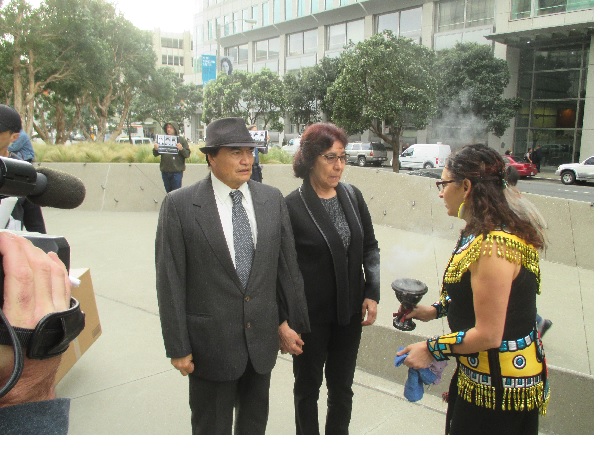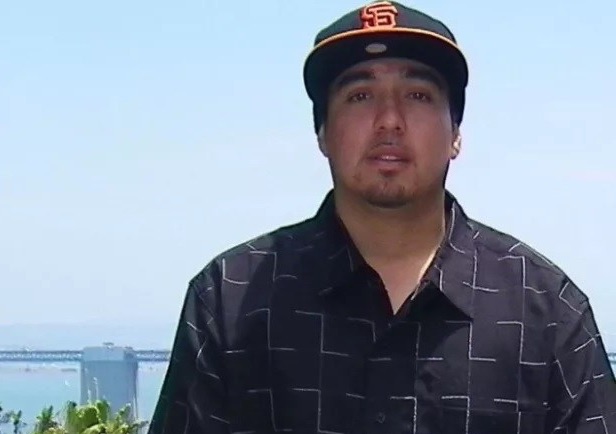In what has been the most overwhelming day in the Alex Nieto trial, the court heard testimony from a range of experts, mostly witnesses called by the city –but it was the testimony of Elvira Nieto that marked the end of the day and provided the emotional evidence of the impact of the shooting.

And during her tearful testimony, the officers who killed her son were busy passing notes and ignoring her.
The day began with the testimony of Officer Roger Morse, who was the last to arrive at the scene but the first to go near Nieto’s body after the shooting. Deputy City Attorney Margaret Baumgartner played back an audio recording from the police radio of Office Morse. “Shots fired, shots fired” the recording said. Baumgartner then played the other half of the recording, pausing briefly to ask if the officer heard anything.
Even though she repeated the question three times, Morse said he was unable to recognize or remember anything of significance from the recording. Baumgartner was trying to demonstrate that police at the scene were yelling commands, a key element of the city’s claim that Nieto ignored warnings to show his hands. She asked Morse if he remembered shouting commands at Nieto as he approached him, but Morse said: “I don’t remember, not at that time. I began shooting”.
He continued: “Nieto was in a prone position, with an arm extended and the gun was in his hand. It looked just like our gun. When his arm was extended, the way I thought he was moving, it made me believe that he had a gun.” Morse said he saw a muzzle flash so he continued to shoot at Nieto, despite the fact that the young man was down on the ground, until he was told to stop shooting. He would later learn that no shots were ever fired from Mr. Nieto and the only gunfire came from his colleagues on the scene.
On cross examination, Morse said he had never seen a Taser, except for in the movies. The jurors, who are allowed to ask questions, posed one: “Can you tell the jurors what you said to Mr. Nieto when you arrived at the scene?
“When I arrived,” Morse said, “I didn’t say anything. I don’t remember. May be I said, don’t move, there might have been some swear words. I don’t remember what I said at that time” he said. Asked if he yelled any commands at Nieto while shooting him, he said: “No I didn’t shout any commands when I was shooting.” he said. That testimony turned out to be of great significance later on in the day.
Next up on the stand was Bryan Chiles, technical compliance manager for Taser International. In an earlier deposition, Chiles had discussed time stamps from the microprocessors on the M26C Taser that Nieto was carrying (he had that weapon because he was about to report to his job as a security guard at a nightclub). The time on the chip did not match the timeline of the incident as narrated by the cops.
In brief, a microprocessor keeps an activity log that can determine the number of times the Taser is used along with timestamps. That could show whether or not Nieto actually pulled the trigger on his Taser during the incident.
However, today, Chiles introduced a different analysis to the court. He told the court that in his previous analysis he hadn’t calculated what is known as a clock drift, the phenomenon that all computer systems tend to deviate over time from the accurate or “true” time.
Chiles said he had calculated that drift, and presented a timeline that matched the testimony of the police officers. He suggested that Nieto’s Taser had been used three times from 7:18 to 7:19 pm. However, on cross examination, several aspects of his testimony proved faulty,
“At that time while discussing the calculation you said your calculations are based on speculation and logic?” Nieto Family Attorney Adante Pointer asked. “Yes” Chiles responded. Fighting back hard, Pointer went on to ask details of the analysis conducted by Chiles. Chiles acknowledged that his analysis took less than a month to complete, involved only ten samples, was never published and has never been peer reviewed.
Pointer then showed Chiles and the jury a photo of Nieto’s Taser as it was photographed at the crime scene. According to the crime scene photo, confirmed by Chiles, Nieto’s Taser was off, or in safe mode — and no laser light could be seen.
In another shot where the Taser could be seen pointing directly at the camera, Chiles testified that there was no laser light visible. “About the image of the trigger. Can you show the jury where you can see whether the Taser was on or off?” Pointer asked?
“It is bright yellow safety, you would be able to tell if it was on and off. The round piece of plastic extends out, when the safety is up it keeps it up, it will keep it on position. It won’t slide back on.” Chiles responded.
It’s hard to figure out how Nieto would have turned the Taser off while being shot at more 50 times.
The court room also heard that since the fatal shooting, Taser International received a contract of $2.3 million to supply the SFPD.
Craig Fries, CEO of Precision Simulations, company that conducts forensic analysis, visualization, and crime scene recreation was up next. According to Fries, the testimony provided by Antonio Theodore, that Nieto’s hands were in his pocket at the time of the shooting did not match the injuries sustained by him.
During his testimony Fries revealed that he had seen pictures of Nieto’s jacket. However, Dr. Amy Hart, the chief medical examiner, testified last week that no photographs of the jacket were ever taken. On cross-examination, Fries could not provide satisfactory responses to how a bone fragment was found in Nieto’s jacket. He did, however admit that he was paid, $325 an hour for his analysis and had spent 200 hours on the case, bringing his total invoice for the San Francisco Police Department to $65,000.
Retired Los Angeles County Deputy Sheriff Roger Lama Clark testified on behalf of the Nieto Family. Clark has testified over 800 times in trials and depositions in more than 1,400 cases around the country.
“I was in two major riots. In 1992, during the Rodney King riots, was put in command of a platoon to protect the federal buildings.” Clark said, “Throughout my career, I came across armed individuals hundreds of times and brought them into custody without firing a shot.”
Despite Clark’s extensive experience in testifying in several courts, including courts in San Francisco, Baumgartner moved to remove him from the witness list claiming he wasn’t an expert.
“That is your argument?” asked US Magistrate Judge Nathanael Cousins “Yes,” Baumgartner said, “Overruled then” announced Judge Cousins, as the court house erupted in laughter.
Clark made several points. “The first point directly deals with the tactical response connected to this unnecessary shooting.” He explained that police officers need to remain calm and discuss strategy during these types of incidents – but the officers involved in the Nieto shooting, who were sitting at the defense table in the courtroom, were clearly dismissive, nodding their heads in disagreement as Clark explained “command, control and communicate.”
“When they saw him (Nieto), rather than keep their distance they reduced the distance, they charged up directly at him rather than observing him. So when they saw him what did they see? He was walking, he was not running, they didn’t need to pursue him and should have dealt with him from the safety of their cars,” Clark said.
He added: “You’ve to assess, what is the totality of the circumstance, possible person armed with a gun? There were no shots fired, no bungling, no flight, no injuries, no one was threatened, the suspect was not running and the individual calling 911 is online. There are a whole lot of other possible reasons for a person to have a gun. So when the officers got to the scene they should have approached him from a distance and issued verbal commands like “Stay there don’t move, listen to us” If he continues to keep going the officer is supposed to say “Stop moving or I will shoot.”
He noted that a command to “show me your hands” is going to lead to a suspect moving his hands around. “If you give an order that expects movement you gotta expect it. Those are things that are taught over and over again,” he said.
The last half hour of the hearing was perhaps the most overwhelming. Alex Nieto’s mother, Elvira Nieto, took the stand, testifying with help of a translator. As a photo of Nieto with President Bill Clinton was projected on the screen, Mrs. Nieto spoke proudly of her son.
“I remember when I first saw this photo, because he was very happy. He felt very happy and content with helping people. He had this photo in an album. Very frequently he would have a look at it,” she said, as tears rolled down her face.
The court saw photographs of Nieto as a child, during his graduation, on family holidays, and at Christmas. The whole courtroom fell silent as we listened to Mrs. Nieto break down quietly as she spoke about her son.
In a shocking display of insensitivity, the officers on trial for use of excessive force that killed Alex Nieto never once looked at the photos displayed on a courtroom screen; instead they spent most of their time scribbling and passing notes to each other as Mrs. Nieto broke down in court.
Nieto frequented Bernal Hill, sometimes twice a day, she said. It was a place he walked with his father as a child and continued to visit it till the day he died. “Now that Alex is gone, Mrs. Nieto, how has that affected your life”? asked Pointer “Well, it has affected me a lot” she said pausing as she broke down, and continued “In the beginning I couldn’t heal. Even now my heart isn’t accepting it that he isn’t here with me any more.”
“And how has it affected your husband?” Pointer asked “Objection” Baumgartner yelled, as if a father’s grief is hearsay. The objection was overruled.
“In the same way it has affected him a lot,” she said. “He goes there every morning, he goes for a walk over there, and sometimes he even goes twice.”





